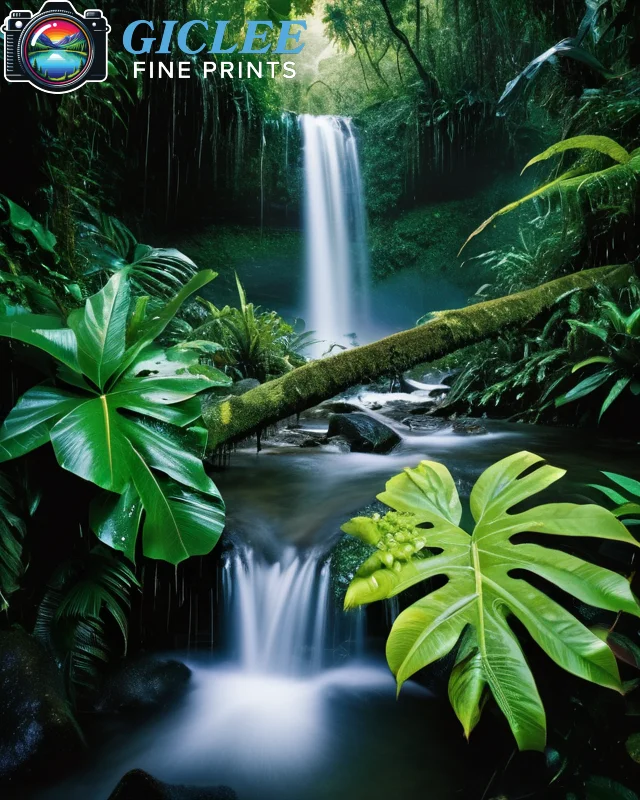
When it comes to displaying your favorite photos or artwork, deciding between canvas prints and traditional photo prints is an important consideration. Each medium offers unique qualities that can enhance the visual appeal of your images, but the best choice depends on your aesthetic preferences, the style of your photo, and how you intend to showcase it. At Giclee Fine Prints, we specialize in both canvas prints and traditional photo prints, helping you choose the right option to fit your needs.
Aesthetic Appeal: Artistic vs. Photographic Look
One of the main differences between canvas prints and traditional photo prints lies in their overall aesthetic and how they present the image.
Canvas Prints:
- Artistic Texture: The textured surface of a canvas print adds depth and a painterly quality to the image, giving it an artistic, gallery-style look. This texture can soften the image, making it appear more like a painting than a traditional photograph.
- Frameless Display: Canvas prints often come with a gallery wrap, where the image extends around the edges of the frame, creating a seamless, frameless appearance. This gives the print a modern and polished look without needing additional framing.
- Best For: Canvas prints are ideal for landscapes, portraits, and abstract artwork that can benefit from the texture and depth that canvas provides. They are perfect for home decor or gallery displays where an artistic look is desired.
Traditional Photo Prints:
- Sharp Detail and Precision: Traditional photo prints on glossy or matte paper provide sharper details and crisper lines, making them ideal for high-resolution photography. The smooth surface ensures that every fine detail of the photo is preserved.
- Framed or Unframed: Traditional photo prints are typically framed, which offers a more classic, formal presentation. The frame adds a finishing touch, making the photo feel more complete and sophisticated.
- Best For: Photo prints are best suited for images that require high detail and sharpness, such as portrait photography, architectural shots, or images where vibrant colors and crisp lines are key.
Durability and Longevity
Both canvas prints and traditional photo prints offer long-lasting durability, but the materials and printing techniques used can affect how well each type holds up over time.
Canvas Prints:
- Highly Durable: Canvas prints are made from sturdy materials like cotton or poly-cotton blends, making them resistant to wear and tear. When printed with archival-quality inks, canvas prints are designed to last for decades without fading or losing their vibrancy.
- Fade-Resistant: The textured surface of the canvas combined with UV-resistant inks makes canvas prints highly resistant to fading, even when exposed to light over long periods.
- Best For: Canvas prints are a great choice for high-traffic areas or rooms where durability is a priority, such as living rooms, offices, or galleries.
Traditional Photo Prints:
- Fragile but Durable with Proper Care: Photo prints on high-quality fine art paper or photo paper can be very durable, especially if printed with archival inks. However, they are more susceptible to damage from moisture, scratches, and bending if not properly framed or protected.
- Framed Protection: Framing a traditional photo print provides added protection, preserving the image for decades. However, unframed prints are more vulnerable to environmental factors.
- Best For: Traditional photo prints are perfect for framing and displaying in more controlled environments, such as bedrooms, offices, or areas with less direct sunlight.

Cost and Affordability
Cost is often a determining factor when choosing between canvas prints and traditional photo prints, and the price can vary based on the size, materials, and printing method used.
Canvas Prints:
- Higher Initial Cost: Canvas prints tend to be more expensive than traditional photo prints due to the cost of the canvas material and the gallery-wrapping process. However, they don’t usually require additional framing, which can offset the initial cost.
- No Framing Needed: Since canvas prints are often displayed without a frame, they offer a cost-effective solution for ready-to-hang art. The gallery-wrapped canvas creates a professional finish without the need for custom framing.
- Best For: If you’re looking for a ready-to-hang display with a more artistic and durable presentation, canvas prints offer great value despite the higher upfront cost.
Traditional Photo Prints:
- Lower Initial Cost: Traditional photo prints are generally more affordable than canvas prints, especially in smaller sizes. The cost of paper and printing tends to be lower, making them a cost-effective option for smaller projects or casual decor.
- Framing Costs: While the initial cost of photo prints may be lower, additional expenses for framing, matting, and glass can increase the total cost. Depending on the size and type of frame, the overall investment may surpass that of a canvas print.
- Best For: Traditional photo prints are ideal for photographers or buyers who prefer the flexibility of choosing custom frames or for those working with smaller budgets.
Customization and Display Options
Both canvas prints and traditional photo prints offer various options for customization, but the flexibility differs based on how each medium is presented.
Canvas Prints:
- Gallery Wrap or Framed: The gallery wrap style of canvas prints creates a frameless, seamless display, which is perfect for minimalist or modern decor. For those who prefer a more traditional look, canvas prints can also be framed, though this is less common.
- Multiple Sizes and Shapes: Canvas prints can be produced in a wide range of sizes and shapes, from small square prints to large panoramic landscapes. This flexibility allows for greater customization in terms of how the artwork is displayed.
- Best For: Canvas prints are ideal for large, statement pieces or wall art where a frameless, bold presentation enhances the decor. They work well in contemporary, minimalist, or gallery-style settings.
Traditional Photo Prints:
- Frame Customization: One of the main advantages of traditional photo prints is the ability to choose custom frames, mats, and glazing options that match your decor. This level of customization allows you to control the overall look and feel of the display.
- Various Paper Finishes: Traditional photo prints can be produced on glossy, matte, luster, or fine art paper, each offering a different look and feel. You can also choose to print on metal prints for a sleek, modern finish.
- Best For: Traditional photo prints offer more flexibility in terms of framing and finishing options, making them ideal for photographers or buyers who want to tailor the display to match a specific interior style.

Image Style and Subject Matter
When choosing between canvas and traditional photo prints, consider the style and subject matter of your image. Some photos lend themselves better to the textured, artistic look of canvas, while others benefit from the crispness of traditional photo prints.
Canvas Prints:
- Best for Art and Portraits: The texture of canvas can soften the details of portraits, making them appear more like paintings. It’s also a great choice for landscape photography, abstract art, or fine art reproductions where the texture adds depth and dimension.
- Great for Large-Scale Art: Canvas prints shine when used for large, statement pieces, as the texture and size can create a gallery-like experience in your home.
Traditional Photo Prints:
- Best for High-Detail Photography: If your image relies on sharpness and fine details, such as architectural photography, wildlife, or macro photography, traditional photo prints are better suited for showcasing these details with precision.
- Great for Smaller, Framed Pieces: Traditional photo prints are ideal for smaller images or photography prints where framing is essential to the overall presentation.
Contact Us
Our address is: 3816 Pioneer Trail Ste #3, South Lake Tahoe, CA 96150
Email: Info@gicleefineprints.com
FAQs
Canvas prints typically have a higher initial cost due to the material and printing process, but they often don’t require framing. Traditional photo prints are usually more affordable but may require custom framing, which can add to the overall cost.
Yes, while most canvas prints are displayed frameless with a gallery wrap, you can also choose to have them framed for a more traditional presentation.
Traditional photo prints on smooth paper are better for high-detail images like macro photography or architectural shots, as they provide sharper lines and more precision.


